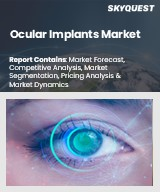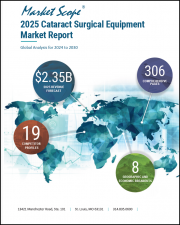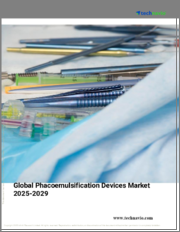
|
시장보고서
상품코드
1661013
세계의 백내장 수술 기기 시장 보고서 : 제품 유형, 최종 용도, 지역별(2025-2033년)Cataract Surgical Devices Market Report by Product Type (Ophthalmic viscoelastic devices, Intraocular lenses, Femtosecond laser, Phacoemulsification equipment, and Others), End-Use, and Region 2025-2033 |
||||||
세계의 백내장 수술 기기 시장 시장 규모는 2024년 92억 달러에 달했습니다. 향후 IMARC Group은 시장이 2033년까지 128억 달러에 이르며 2025년부터 2033년까지 3.48%의 성장률(CAGR)을 나타낼 것으로 예측했습니다. 백내장 증례 수 증가, 펨토 세컨드 레이저 및 초음파 유화 흡입 시스템과 같은 고성능 기기의 도입, 세계 건강 관리 지출 증가, 건강 관리 서비스 접근성 향상 등이 시장을 견인하는 주요 요인입니다.
백내장 수술 기기란, 백내장 수술 시에 사용되는 다양한 특수 기구나 기기로, 탁한 수정체(백내장)를 안구에서 제거하고 인공 안구 렌즈(IOL)로 대체하는 일반적인 수술 방법입니다. 백내장은 시력 장애나 실명을 일으키지만 백내장 수술은 시력을 회복하고 환자의 삶의 질을 향상시키는 효과적인 방법입니다. 백내장 수술 기구는 백내장 수술을 최소한의 위험으로 성공시키고 치료 성적을 향상시키는 데 중요한 역할을 합니다. 기술의 진보로 백내장 수술에 혁명을 일으키는 세련된 기기가 개발되어 백내장 수술은 세계적으로 가장 흔하고 성공률이 높은 수술법의 하나가 되고 있습니다.
이 시장은 업계의 몇 가지 중요한 촉진요인과 동향에 힘입어 큰 성장을 이루고 있습니다. 백내장 수술 기기의 기술적 진보는 시장 성장 추진에 매우 중요한 역할을 합니다. 펨토 세컨드 레이저 지원 백내장 수술과 고급 안구 렌즈 재료와 같은 기술 혁신은 수술 정확도를 향상시켜 더 나은 치료 결과와 환자의 회복 시간을 단축시킵니다. 또한, 눈 건강에 대한 의식 증가와 고급 치료 옵션의 가용성은 환자의 선호에 영향을 미칩니다. 환자는 삶의 질과 시력을 유지하기 위해 백내장의 초기 단계에서 수술을 원합니다. 그 결과, 고품질 백내장 수술에 대한 수요 증가가 백내장 수술 기기 시장 성장을 뒷받침하고 있습니다. 또한 아시아, 라틴아메리카, 아프리카의 신흥 국가에서는 주로 건강 관리 인프라 개선, 가처분 소득 증가, 눈 건강에 대한 인식이 높아짐에 따라 백내장 수술 기기에 대한 수요가 급증하고 있습니다. 건강 관리 시설에 대한 접근성이 개선됨에 따라 백내장 수술을 원하는 환자 수가 증가하여 세계 시장 확대에 기여하고 있습니다.
백내장 수술 기기 시장 경향/촉진요인:
백내장 유병률 증가와 노인 인구 증가
세계 인구의 고령화는 시장에 영향을 미치는 주요 요인 중 하나입니다. 노화가 진행됨에 따라 백내장이 발생할 위험이 크게 증가합니다. 백내장은 노화와 관련된 일반적인 눈 질환으로 눈의 수정체가 혼탁하여 시야가 흐려지거나 시력이 저하됩니다. 세계 인구의 장수화에 따라 백내장으로 진단받는 사람은 증가의 길을 따라가고 있습니다. 그 결과 백내장 수술 및 관련 수술 기기에 대한 수요가 증가하고 있습니다. 노인층은 시력을 회복하고 전반적인 삶의 질을 향상시키기 위해 효과적이고 안전한 치료법을 찾고 있습니다. 이 인구 역학의 변화는 제조업체의 연구 개발에 대한 엄청난 투자에 박차를 가하고 더 나은 치료 결과, 회복 시간 단축 및 환자 만족도 향상을 제공하는 첨단 백내장 수술 기기의 도입으로 이어집니다.
다양한 기술의 진보
백내장 수술 기기에서 끊임없는 기술의 발전과 혁신은 안과 분야에 혁명을 일으켰습니다. 이러한 혁신은 시장의 성장을 가속하는데 매우 중요한 역할을 합니다. 제조업체는 백내장 수술의 효율성과 안전성을 높이기 위해 항상 새로운 재료, 디자인 및 수술 기술을 모색하고 있습니다. 중요한 발전 중 하나는 펨토 세컨드 레이저 지원 백내장 수술(FLACS)의 도입입니다. FLACS를 통해 외과의사는 백내장 수술의 다양한 단계를 보다 정확하게 수행할 수 있어 합병증의 위험을 최소화하고 시력 결과를 개선할 수 있습니다. 또한, 프리미엄 안구내 렌즈(IOL)의 개발은 백내장 환자의 치료 옵션을 넓혔습니다. 프리미엄 안구내 렌즈는 다초점, 초점 심도 확대, 난시 교정 등의 기능을 갖추고 있어 환자는 안경에 의존하지 않고 다양한 거리에서 선명한 시야를 얻을 수 있습니다.
신흥국 수요 증가
신흥경제국에서 백내장 수술 기기에 대한 수요 증가도 시장에 영향을 미치는 중요한 요소입니다. 아시아, 라틴아메리카 및 아프리카 국가에서 건강 관리 인프라가 개선되고 가처분 소득이 증가함에 따라 백내장 수술에 대한 접근성이 높아지고 있습니다. 눈 건강에 대한 의식이 높아지고, 의료 시설 액세스가 개선됨으로써, 백내장의 치료를 희망하는 사람이 증가하고 있습니다. 또한 이 지역의 정부와 의료기관은 백내장으로 인한 시각장애 부담에 대처하기 위해 눈 건강에 대한 노력을 적극적으로 추진하고 백내장 수술 보조금을 제공합니다. 이러한 적극적인 접근법은 수술 건수를 증가시킬 뿐만 아니라 첨단 백내장 수술 기기의 채용을 촉진하고 있습니다.
목차
제1장 서문
제2장 조사 범위와 조사 방법
- 조사의 목적
- 이해관계자
- 데이터 소스
- 1차 정보
- 2차 정보
- 시장 추정
- 상향식 접근
- 하향식 접근
- 조사 방법
제3장 주요 요약
제4장 소개
- 개요
- 주요 업계 동향
제5장 세계의 백내장 수술 기기 시장
- 시장 개요
- 시장 실적
- COVID-19의 영향
- 시장 분석 : 제품 유형별
- 시장 내역 : 최종 용도별
- 시장 분석 : 지역별
- 시장 예측
- SWOT 분석
- 개요
- 강점
- 약점
- 기회
- 위협
- 밸류체인 분석
- 개요
- 연구개발
- 원재료 조달
- 제조
- 마케팅
- 유통
- 최종 용도
- Porter's Five Forces 분석
- 개요
- 구매자의 협상력
- 공급기업의 협상력
- 경쟁도
- 신규 참가업체의 위협
- 대체품의 위협
제6장 시장 내역: 제품 유형별
- 안내 렌즈
- 시장 동향
- 시장 예측
- 안과용 점탄성 기기
- 시장 동향
- 시장 예측
- 펨토초 레이저
- 시장 동향
- 시장 예측
- 초음파 유화 흡입 기기
- 시장 동향
- 시장 예측
- 기타
- 시장 동향
- 시장 예측
제7장 시장 내역: 최종 용도별
- 병원
- 시장 동향
- 시장 예측
- 안과 클리닉
- 시장 동향
- 시장 예측
- 안과 치료 및 외과 센터
- 시장 동향
- 시장 예측
제8장 시장 분석 : 지역별
- 북미
- 시장 동향
- 시장 예측
- 유럽
- 시장 동향
- 시장 예측
- 아시아태평양
- 시장 동향
- 시장 예측
- 라틴아메리카
- 시장 동향
- 시장 예측
- 중동 및 아프리카
- 시장 동향
- 시장 예측
제9장 백내장 수술 기기의 제조 공정
- 제품 개요
- 원재료 요건
- 제조 공정
- 주요 성공 요인과 위험 요인
제10장 경쟁 구도
- 시장 구조
- 주요 기업
- 주요 기업 프로파일
- Abbott Laboratories
- Hoya Corporation
- Carl Zeiss Meditec AG
- Alcon Laboratories, Inc.
- Essilor International SA
The global cataract surgical devices market size reached USD 9.2 Billion in 2024. Looking forward, IMARC Group expects the market to reach USD 12.8 Billion by 2033, exhibiting a growth rate (CAGR) of 3.48% during 2025-2033. The growing number of cataract cases, the introduction of sophisticated devices, such as femtosecond lasers and phacoemulsification systems, the growing global healthcare expenditure and the improved access to healthcare services represent some of the key factors driving the market.
Cataract surgical devices refer to a range of specialized instruments and equipment used during cataract surgery, a common surgical procedure to remove a cloudy lens (cataract) from the eye and replace it with an artificial intraocular lens (IOL). Cataracts can cause vision impairment or blindness, and cataract surgery is an effective method to restore vision and improve the quality of life for patients. Cataract surgical devices play a vital role in ensuring successful cataract surgeries with minimal risk and improved outcomes. Advances in technology have led to the development of sophisticated devices that have revolutionized cataract surgery, making it one of the most common and successful surgical procedures globally.
The market is experiencing significant growth, driven by several key drivers and trends in the industry. Technological advancements in cataract surgical devices have played a pivotal role in propelling market growth. Innovations such as femtosecond laser-assisted cataract surgery and advanced IOL materials have improved surgical precision, leading to better outcomes and quicker patient recovery times. Moreover, the increasing awareness of eye health and the availability of advanced treatment options are influencing patient preferences. Patients are now more willing to undergo cataract surgery at an earlier stage of the condition to maintain their quality of life and visual acuity. Consequently, the rising demand for high-quality cataract surgical procedures is bolstering the market growth of cataract surgical devices. Besides, the emerging economies in Asia, Latin America, and Africa are witnessing a surge in demand for cataract surgical devices, primarily due to improving healthcare infrastructure, rising disposable incomes, and growing awareness about eye health. As access to healthcare facilities improves, a larger patient pool seeks cataract surgery, contributing to the expansion of the global market.
Cataract Surgical Devices Market Trends/Drivers:
Growing prevalence of cataract and rising geriatric population
The aging global population is one of the primary factors impacting the market. As people age, the risk of developing cataracts increases significantly. Cataracts are a common age-related eye condition characterized by the clouding of the eye's natural lens, leading to blurred vision and decreased visual acuity. With the world's population living longer than ever before, the number of individuals diagnosed with cataracts is on the rise. As a result, there is a growing demand for cataract surgeries and related surgical devices. The elderly population seeks effective and safe treatment options to restore their vision and improve their overall quality of life. This demographic shift has spurred significant investments in research and development by manufacturers, leading to the introduction of advanced cataract surgical devices that offer better outcomes, shorter recovery times, and enhanced patient satisfaction.
Various technological advancements
Continuous technological advancements and innovations in cataract surgical devices have revolutionized the field of ophthalmology. These innovations have played a pivotal role in driving market growth. Manufacturers are constantly exploring new materials, designs, and surgical techniques to enhance the efficiency and safety of cataract surgeries. One significant advancement is the introduction of femtosecond laser-assisted cataract surgery (FLACS), which provides precise and reproducible incisions during the procedure. FLACS enables the surgeon to perform various steps of cataract surgery with increased accuracy, minimizing the risk of complications and improving visual outcomes. Additionally, the development of premium intraocular lenses (IOLs) has expanded treatment options for cataract patients. Premium IOLs offer features such as multifocality, extended depth of focus, and astigmatism correction, allowing patients to achieve clear vision at different distances without relying on glasses.
Increasing demand in emerging economies
The growing demand for cataract surgical devices in emerging economies is another significant factor influencing the market. As healthcare infrastructure improves and disposable incomes rise in countries across Asia, Latin America, and Africa, the accessibility of cataract surgeries has increased. With greater awareness of eye health and improved access to medical facilities, more individuals are seeking treatment for cataracts. Furthermore, governments and healthcare organizations in these regions are actively promoting eye health initiatives and offering subsidized cataract surgeries to tackle the burden of visual impairment caused by cataracts. This proactive approach has not only boosted the number of surgeries performed but also fostered the adoption of advanced cataract surgical devices.
Cataract Surgical Devices Industry Segmentation:
Breakup by Product Type:
- Ophthalmic viscoelastic devices (OVDs)
- Intraocular lenses (IOLs)
- Femtosecond laser
- Phacoemulsification equipment
- Others
Intraocular lenses represent the most popular product type
Intraocular lenses are a crucial component of cataract surgery, as they play a pivotal role in restoring vision after the cloudy natural lens has been removed. Cataracts cause significant visual impairment, and IOLs offer an effective and reliable solution to replace the clouded lens with an artificial one, allowing patients to regain clear vision. Moreover, the field of intraocular lenses has witnessed significant technological advancements over the years. Manufacturers have continually improved the design and materials used in IOLs to enhance optical performance and patient comfort. For example, the introduction of multifocal and extended depth of focus IOLs allows individuals to achieve clear vision at various distances, reducing the reliance on glasses post-surgery.
Breakup by End-Use:
- Hospitals
- Eye care clinics
- Eye Treatment and Surgical Centres
Hospitals hold the largest market share
Hospitals are equipped with advanced surgical facilities and a skilled team of ophthalmic surgeons who specialize in cataract surgery. Cataract surgery is a delicate procedure that requires precision and expertise, and hospitals are well-equipped to provide the necessary resources and personnel to perform these surgeries effectively. Moreover, hospitals offer comprehensive eye care services, making them a go-to choice for patients seeking cataract treatment. From pre-operative evaluations and diagnostics to post-operative follow-ups, hospitals provide all-inclusive care, ensuring the best possible outcomes for patients undergoing cataract surgery. Apart from this, many ophthalmologists and eye care specialists practice in hospitals. These professionals refer patients with cataracts to their affiliated hospitals for surgical procedures, further boosting the hospitals' market share in the market.
Breakup by Region:
- Europe
- North America
- Latin America
- Asia Pacific
- Middle East and Africa
North America accounts for the majority of market share
The report has also provided a comprehensive analysis of all the major regional markets, which include North America, Asia-Pacific, Europe, Latin America, and the Middle East and Africa. According to the report, North America accounted for the largest market share.
North America, particularly the United States, has a significant aging population. With age being a primary risk factor for cataracts, the region experiences a higher prevalence of cataract cases. As a result, there is a substantial demand for cataract surgeries and related surgical devices, driving the market share in the region. Besides, North America boasts a well-developed and advanced healthcare infrastructure with a wide network of hospitals, ambulatory surgical centers (ASCs), and specialty eye clinics. This infrastructure facilitates easy access to cataract surgeries, making them more readily available to patients. The availability of state-of-the-art medical facilities and skilled ophthalmic surgeons contributes to the region's higher market share.
Competitive Landscape:
The competitive landscape of the market is characterized by the presence of several established medical device companies, along with emerging players, striving to gain a foothold in the industry. Nowadays, key players are offering a wide array of cataract surgical devices, including different types of intraocular lenses (IOLs) with varying features (multifocal, toric, and accommodating), phacoemulsification systems, and other surgical instruments. They are also expanding their market presence by entering new geographic regions and establishing partnerships with local distributors and healthcare facilities. Besides, to maintain credibility and gain the trust of patients and healthcare providers, key players are ensuring strict adherence to international regulatory standards and obtain necessary certifications for their products.
The report has provided a comprehensive analysis of the competitive landscape in the market. Detailed profiles of all major companies have also been provided. Some of the key players in the market include:
- Abbott Laboratories
- Hoya Corporation
- Carl Zeiss Meditec AG
- Alcon Laboratories Inc.
- Essilor International S.A.
Key Questions Answered in This Report
- 1.What was the size of the global cataract surgical devices market in 2024?
- 2.What is the expected growth rate of the global cataract surgical devices market during 2025-2033?
- 3.What are the key factors driving the global cataract surgical devices market?
- 4.What has been the impact of COVID-19 on the global cataract surgical devices market?
- 5.What is the breakup of the global cataract surgical devices market based on the product type?
- 6.What is the breakup of the global cataract surgical devices market based on the end-use?
- 7.What are the key regions in the global cataract surgical devices market?
- 8.Who are the key players/companies in the global cataract surgical devices market?
Table of Contents
1 Preface
2 Scope and Methodology
- 2.1 Objectives of the Study
- 2.2 Stakeholders
- 2.3 Data Sources
- 2.3.1 Primary Sources
- 2.3.2 Secondary Sources
- 2.4 Market Estimation
- 2.4.1 Bottom-Up Approach
- 2.4.2 Top-Down Approach
- 2.5 Forecasting Methodology
3 Executive Summary
4 Introduction
- 4.1 Overview
- 4.2 Key Industry Trends
5 Global Cataract Surgical Devices Market
- 5.1 Market Overview
- 5.2 Market Performance
- 5.3 Impact of COVID-19
- 5.4 Market Breakup by Product Type
- 5.5 Market Breakup by End-Use
- 5.6 Market Breakup by Region
- 5.7 Market Forecast
- 5.8 SWOT Analysis
- 5.8.1 Overview
- 5.8.2 Strengths
- 5.8.3 Weaknesses
- 5.8.4 Opportunities
- 5.8.5 Threats
- 5.9 Value Chain Analysis
- 5.9.1 Overview
- 5.9.2 Research and Development
- 5.9.3 Raw Material Procurement
- 5.9.4 Manufacturing
- 5.9.5 Marketing
- 5.9.6 Distribution
- 5.9.7 End-Use
- 5.10 Porters Five Forces Analysis
- 5.10.1 Overview
- 5.10.2 Bargaining Power of Buyers
- 5.10.3 Bargaining Power of Suppliers
- 5.10.4 Degree of Competition
- 5.10.5 Threat of New Entrants
- 5.10.6 Threat of Substitutes
6 Market Breakup by Product Type
- 6.1 Intraocular Lenses
- 6.1.1 Market Trends
- 6.1.2 Market Forecast
- 6.2 Ophthalmic Viscoelastic Devices
- 6.2.1 Market Trends
- 6.2.2 Market Forecast
- 6.3 Femtosecond Laser
- 6.3.1 Market Trends
- 6.3.2 Market Forecast
- 6.4 Phacoemulsification Equipment
- 6.4.1 Market Trends
- 6.4.2 Market Forecast
- 6.5 Others
- 6.5.1 Market Trends
- 6.5.2 Market Forecast
7 Market Breakup by End-Use
- 7.1 Hospitals
- 7.1.1 Market Trends
- 7.1.2 Market Forecast
- 7.2 Eye Care Clinics
- 7.2.1 Market Trends
- 7.2.2 Market Forecast
- 7.3 Eye Treatment and Surgical Centres
- 7.3.1 Market Trends
- 7.3.2 Market Forecast
8 Market Breakup by Region
- 8.1 North America
- 8.1.1 Market Trends
- 8.1.2 Market Forecast
- 8.2 Europe
- 8.2.1 Market Trends
- 8.2.2 Market Forecast
- 8.3 Asia Pacific
- 8.3.1 Market Trends
- 8.3.2 Market Forecast
- 8.4 Latin America
- 8.4.1 Market Trends
- 8.4.2 Market Forecast
- 8.5 Middle East and Africa
- 8.5.1 Market Trends
- 8.5.2 Market Forecast
9 Cataract Surgical Devices Manufacturing Process
- 9.1 Product Overview
- 9.2 Raw Material Requirements
- 9.3 Manufacturing Process
- 9.4 Key Success and Risk Factors
10 Competitive Landscape
- 10.1 Market Structure
- 10.2 Key Players
- 10.3 Profiles of Key Players
- 10.3.1 Abbott Laboratories
- 10.3.1.1 Company Overview
- 10.3.1.2 Description
- 10.3.1.3 Product Portfolio
- 10.3.1.4 Financials
- 10.3.1.5 SWOT Analysis
- 10.3.2 Hoya Corporation
- 10.3.2.1 Company Overview
- 10.3.2.2 Description
- 10.3.2.3 Product Portfolio
- 10.3.2.4 Financials
- 10.3.2.5 SWOT Analysis
- 10.3.3 Carl Zeiss Meditec AG
- 10.3.3.1 Company Overview
- 10.3.3.2 Description
- 10.3.3.3 Product Portfolio
- 10.3.3.4 Financials
- 10.3.3.5 SWOT Analysis
- 10.3.4 Alcon Laboratories, Inc.
- 10.3.4.1 Company Overview
- 10.3.4.2 Description
- 10.3.4.3 Product Portfolio
- 10.3.5 Essilor International S.A.
- 10.3.5.1 Company Overview
- 10.3.5.2 Description
- 10.3.5.3 Product Portfolio
- 10.3.5.4 Financials
- 10.3.5.5 SWOT Analysis
- 10.3.1 Abbott Laboratories



















